
When you see apples in a supermarket, neighborhood kiosk, or with street vendors, do ever wonder where they come from? Do you ever imagine an apple tree, how it looks like or what a garden full of apples is like? I bet most of you don’t and the same here I don’t, never did until about 2 years ago.
I had gone into a social media rabbit hole, you know-how go to check something on one platform say Facebook, and 2-3 hours later you are darting between that, Twitter, Instagram, and the whole lot. You know what I mean, but this article is not about social media. This article is about apples and an apple farm. So, back to the social media bender, I came across a post on Twitter about an Apple Farm in Kabale, I took a screenshot out of curiosity. Many moons later, I was checking my phone and going through the screenshots and there it was trying not to expire from the gallery like most things. I saved the number and made a mental note to visit it sometime. That sometime was 8th April 2022!
When I called the number, I had saved it as Apple Farm Stay Kabale and a lady picked it up. I introduced myself and my purpose for the call. She seemed a bit surprised, and she asked me if I was a researcher or with a student group. I told her I wasn’t any of those save for a curious local wishing to see where apples come from. And you’ll never guess what, it happened that the time I decided I would visit, was the harvesting season. Just my luck! Dear reader, I am not sure about my lucky streak, never won anything in any draws, or competitions (in my adult life..lol) and it wasn’t for a lack of trying. This was fantastic and I knew it was the sign that I had to go. Caroline whom I, unfortunately, didn’t have a chance to meet connected me to her husband Peter who was the designated guide. Peter was an amazing guide and well I haven’t met anyone so passionate about farming lately. By the end of the tour about 2 hours later, I was impressed, challenged, and in awe.
We started the tour at a chicken house and at first, I didn’t get the connection between apples and chicken. The chicken was being fed, and as we exited the chicken house, Peter showed us a soil mound which he mentioned was chicken droppings. He mentioned they use it as manure for the apples. I thought oh, okay, and off we went, walked a small distance, and branched off to a narrow climbing path that ushered us into the apple garden.
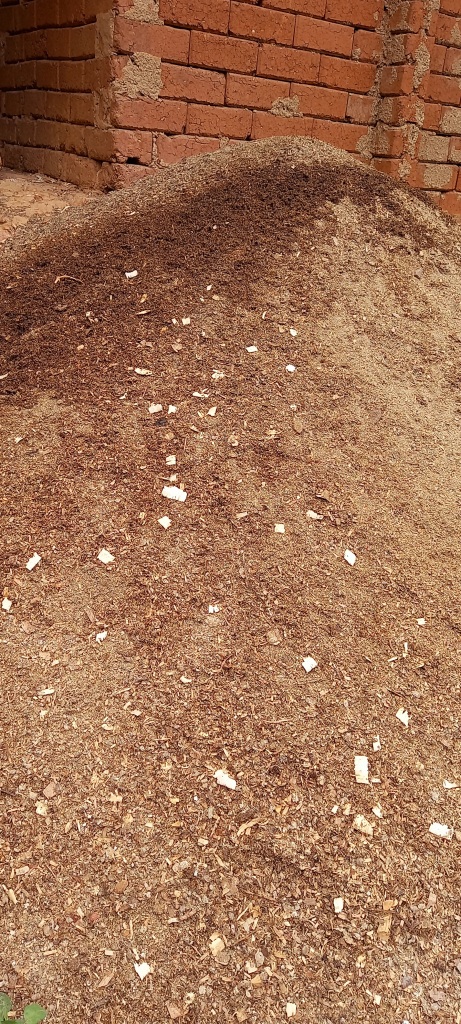
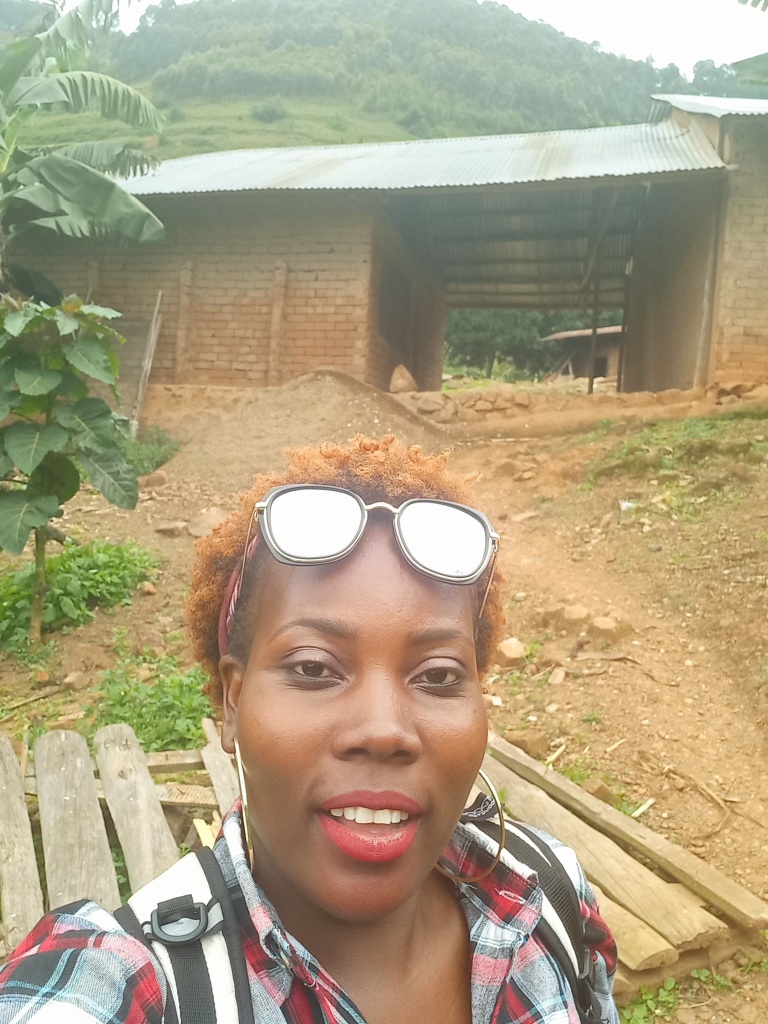
First impressions
It wasn’t at all what I expected but at the same time, I realized that in my built-up anticipation, the thought of how the trees would look had not registered. I had mixed feelings upon seeing the trees. They are rather short and carry many branches, some of them at least, their leaves are different. I have nothing to compare them with, I thought of lemon and orange tree leaves but no, they don’t look like that. The first trees I saw didn’t have as many leaves too but as we walked up the garden, there were leafier trees and they had apples on them. Peter explained that the first trees I saw hadn’t done well that season hence the withering look.


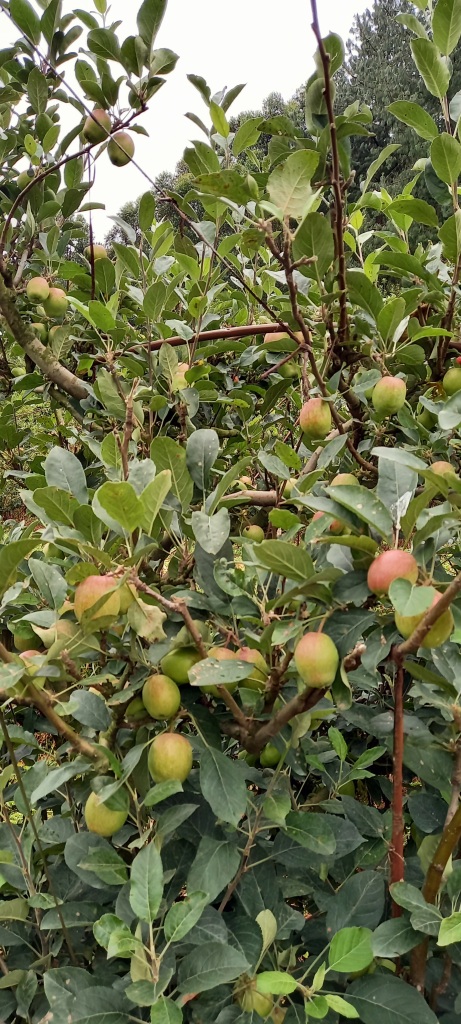

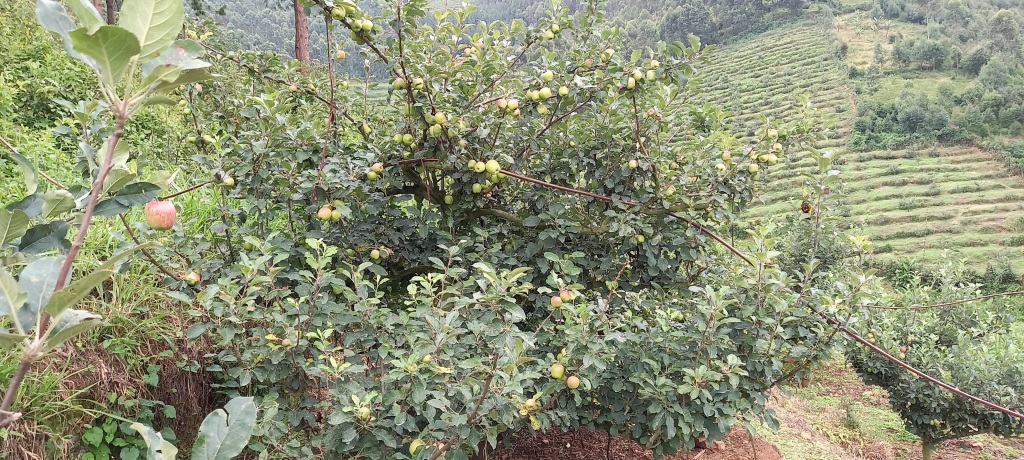
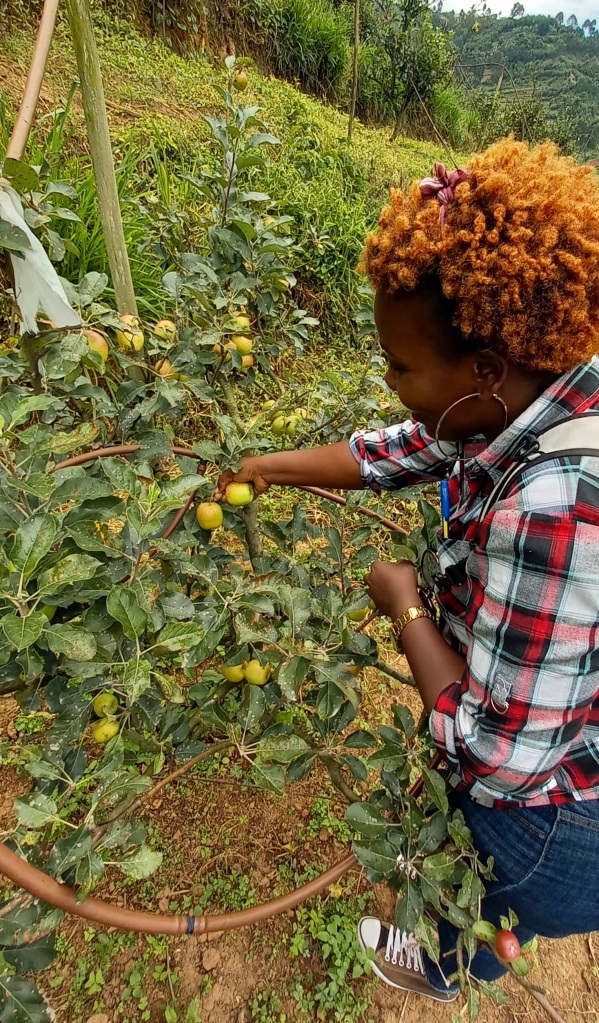
As expected of the terrain in the area, the farm is on a slope, and we had to up as went about the garden. It was a surreal experience to be there in the middle of an apple garden and see the fruit trees everywhere I turned. I remember thinking wow, you are here, and this is pretty cool!
Fun facts about apples and their farming as learnt on the farm
Did you know that there are over 7000 apple varieties in existence around the world? However, on Peter’s farm, they grow only three types. Dorsett Golden, Anna and Winter Banana apples.



Apples grow best in temperate climates reason why most of the apples we have on the local market are imported from areas that experience that type of climate. Growing them in our kind of climate is sort of an uphill task but doable as the likes of Peter have managed to hack their way around it and have a thriving farm.
He said they have two seasons in a year that are targeted according to the weather patterns. The process involves a complete pruning of each of the trees to “induce “flowering. They manually remove every single leaf from each of the trees leaving them bare. The trick is that without leaves, the trees “assume” winter has fallen. Around this period, they develop buds that develop into flowers, and slowly by slowly the leaves start growing again. It’s the flowers that later turn into apples. When I visited, it was the first harvest season of the year and when they complete the season, they will have trees rest before they prune in August when the weather is relatively dry. Around September the trees will start flowering and it takes about 3 months for them to mature for harvest
While the matured apples have a reddish shade, Peter intimated that the species he grows are green apples and the reddening is a result of them being directly hit by the sunlight. I saw this as the apples that were hidden under more leaves were all green.

Taking care of apple trees
Before I delve into what Peter shared, I will share my sentiments about the information he so passionately shared.
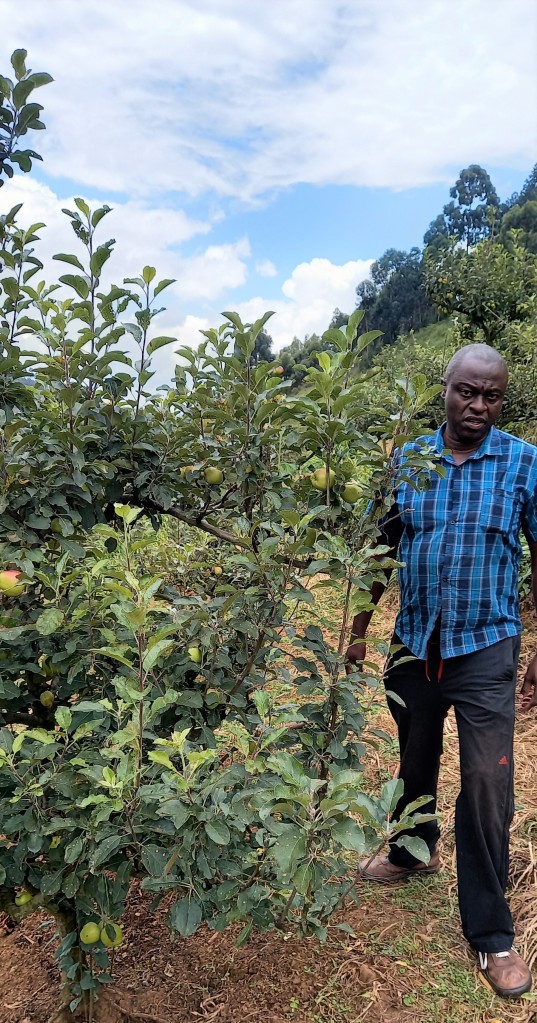
For one to get the most from their apple trees a lot of care has to be exercised. It’s literally like taking care of a human where you ensure every step of growth is closely monitored, ensuring that the trees are well fed in this case with fertilizer, enough water, and regular spraying to wane off the diseases and pests. It turns out apple trees are highly susceptible to crop diseases. I felt that Peter could distinguish each apple tree from the thousands of trees growing on the six acres of land that they cover. This was from the way he aptly described the attributes of almost every tree, and I was in awe. It was the full immersion and understanding of his garden, how he talked about it and described different processes of how the garden is run, cared for and I was blown away. I thought, this is how you farm. Not half-heartedly, not from afar, and certainly not from the phone (we know some phone farmers…). He reminded me of my father who is retired and now into full-time farming. It’s just beautiful to see and feel the warmth emanated from a person as they talk about something. Peter exuded all this. No wonder he scooped the second runner-up place in the Vision Group’s best farmer competition in 2020.
Lastly, just like with life ventures, sometimes even with all the care and doing a lot of things right for the trees, some of them disappoint. For instance, a tree will be pruned and doesn’t flower or delay flowering while the rest bloom.
He says to get the most of each of the trees, you cannot half invest in taking care of them. That means checking them regularly for instance around the fruiting season to ensure each has fruits it can carry for its size. If a tree is carrying more than its weight, some of the fruits are removed. Also, from the monitoring, we ensure that the apples that are not maturing well are removed to give rooms for others to grow well. Peter’s farm is over 15 years having ventured out in 2016.
The challenges
Apple trees are highly susceptible to disease which requires regular spraying with insecticides. We also have to do a lot of pest control and at times we have to get rid of some of the plants and replace them. We also have to deal with the birds that pick at the apples. We have also experienced seasons where the harvest has been very poor and during such times, there have been thoughts of giving up on the farm. But somehow, we keep going and here we are.
Highlights
High-yielding trees can produce over 50 kilograms of apples in a season. With each kilogram costing UGX 4000, that can be over Ugx 200,000 gained from each tree. He sells the apples locally within Kabale town. On average, he invests around 9-10 million UGX in the season. This caters to paying the workers, irrigation, purchase of fertilizer, and insecticides among other expenses.
When the apples are harvested, they are sorted. The well-sized apples are sold while the smaller sizes are used to make wine. I had the chance to taste wine made out of apples and while I am not a wine connoisseur when compared to other locally made wines I have tasted, it was good. It was on promotion at the time I visited, and I got a 1 and a half-liter bottle at UGX 20000. This likely has changed or not but you can reach out to Peter on 0392548462 for more details.



Dreams for the farm
I dream of a time when I can consistently earn more than half or double the investment, I inject into the farm every season. I also look at a time when we have sufficient information and proven research about apple farming to make it a lot easier. I think this would also get more people into apple farming. As much as there is some information available, it’s not as well-tailored to the Ugandan setting, so you find we have to figure out most things are we go along. For instance, you have to experience a terrible season where the harvest is poor that the next season you have to restrategize and work out how to do better in the next season.
I also wish to have more people visit the farm and take part in activities such as apple picking. He intimated that he was expecting a guest that had booked to pick apples from 10 trees.
Inspiration
Peter said that in his early years, one of his neighbors kept about 5 apple trees. “They yielded well and I used to buy apples from him each for around 500ugx and at the time this was pricey. In those 5 trees, he earned a livelihood for the longest time, and it sparked my desire to venture into apple farming. I also visited an apple farm in Korea and I remember holding a good-looking apple in my hand with it attached to the tree and I knew I had to venture into it. Apples are a perennial crop that if well maintained can for the longest period be a continuous source of income.” he said.
Ecosystem on the farm
Peter said he purposed to have a chicken farm in order to have a steady supply of manure for the apple farm and that reduces the amount of artificial fertilizer he has to use. His farm is not so far from L. Bunyonyi so the water that irrigates the farm is pumped from the lake. He also keeps some turkeys that are released upon the completion of harvesting. They wander in the garden and eat the weeds. This helps with weed control during the off seasons.
Lessons
- If you’re not ready to put in the time and be present on a farm, think twice about growing apples.
- Growing apples is not a get-rich-quick scheme as it’s not the type of crop that can yield in a short period but long-term it pays well if one does it right.
- I am not sure I see farming in my future, but should I venture into it at some point, I want to be as passionate as Peter is about farming. But in the meantime, I am roping my father into apple farming. I am excited about this, and I will endeavor to keep you updated about this.

If this article piques your curiosity and you want to go check out the apple farm, call Peter on 0392548462 for more details. They also have accommodation, and you can stay on the farm while touring the rest of what L. Bunyonyi and its Islands have to offer. I will share more about the Island and its activities in the next blog post.

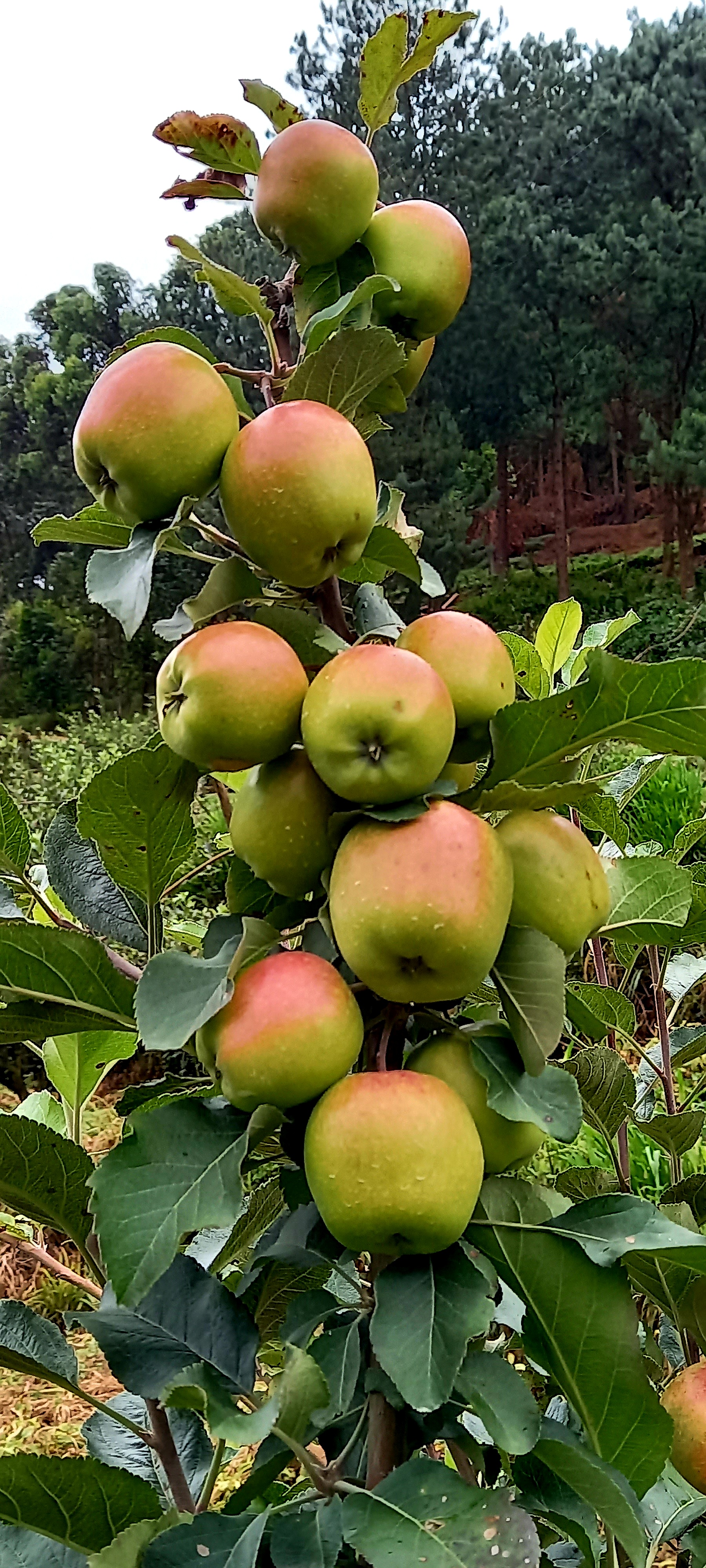
I always believed Apples are exclusively imported. Now I know its doable locally… though the only one I have seen was hidden by the fence, not cared for and produced just a couple of fruits for fun. Guess it grew by sheer accident.
This is a nice read Brenda…. just don’t push mzeeey into what he may not be passionate about. lol!!
LikeLiked by 1 person
Hhaha, glad to share this exclusive about apple farming with all of you! Mzee, I anticipate will be excited to have a new muse on his farm!
LikeLike
Hahaha, I will sow seeds and hope they’ll fall on receptive ears:). And hey, the things you learn when you travel, so much.
LikeLike